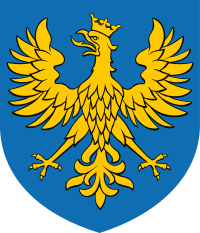Jan III of Oświęcim
Jan III of Oświęcim (Polish: Jan III oświęcimski) (1366 – by 19 August 1405) was a Duke of Oświęcim since 1376 until his death.
Jan III | |
|---|---|
| Duke of Oświęcim | |
 Coat-of-arms of Upper Silesia (Opole, Oświęcim, etc) | |
| Born | 1366 |
| Died | by 19 August 1405 |
| Noble family | Silesian Piasts of Opole |
| Spouse(s) | Hedwig of Lithuania |
| Father | Jan II of Oświęcim |
| Mother | Hedwig of Brzeg |
He was the eldest child and only son of Duke Jan II of Oświęcim by his wife Hedwig, daughter of Ludwik I the Fair, Duke of Brzeg.[1][2][3][4] Initially, historians thought that Dukes Jan II and Jan III are the same person, until the discovery of further sources who confirmed Jan III's existence.
Life
Little is known about Jan III's rule. It is possible that, like his grandfather Jan I the Scholastic, he was initially designed to the Church. This is confirmed by a document dated from 1379, where Jan III is called Scholastic of Kraków (although this could be a confusion with Jan I). Another proof of the presumed destination of Jan III to the spiritual career was the agreement in 1372, under which Jan II ensured the inheritance of Oświęcim to Przemysław I Noszak, Duke of Cieszyn on his death.
However, after Jan II's death in 1376, his son could succeeded him, but under the guardianship of Przemysław I Noszak. This fact confirms by a document from 25 November 1377 in which the Duke of Cieszyn approves the Oświęcim succession.
Despite his sujetion to the Duchy of Cieszyn, Jan III tried to hold an independent policy. In 1394 he married to Hedwig (d. aft. 13 May 1400), daughter of Algirdas, Grand Duke of Lithuania and sister of King Władysław II Jagiełło of Poland,[5][6] which enabled him to improved the relations between Poland and his relative Władysław Opolczyk.
In 1397, together with the other Silesian Dukes and the Bishop of Wrocław, Jan III signed in Legnica an arrangement with the Polish King, to guarantee the common action against robbery. In 1399, Jan III tried to appease the anger of King Władysław II Jagiełło against the Bishop-Duke of Opole Jan Kropidło.
In the internal politics, Jan III promoted and supported the development of the cities (granting privileges, among others, to the districts of Kęty and Zator) and the Church (in particular, like his father and grandfather, to the Dominicans).
The last document in which Jan III appears dated from 1402. However, the historians conclude that Jan III died around three years later. He was buried in the Dominican monastery in Oświęcim.
On his death without issue, Oświęcim was annexed to the Duchy of Cieszyn.[7]
References
- Marek, Miroslav. "Complete Genealogy of the House of Piast". Genealogy.EU.
- Cawley, Charles, SILESIA, Medieval Lands database, Foundation for Medieval Genealogy,
- Chronological Dates in Stoyan
- Genealogy of the Dukes of Cieszyn
- Marek, Miroslav. "Genealogy of the Dukes of Lithuania". Genealogy.EU.
- Cawley, Charles, LITHUANIA, Medieval Lands database, Foundation for Medieval Genealogy,
- This article was translated from his original in Polish Wikipedia.
| Preceded by Jan II |
Duke of Oświęcim 1376–1405 |
Succeeded by Przemysław |